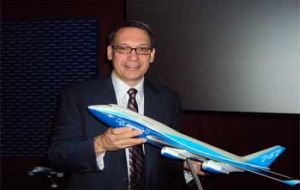MercoPress. South Atlantic News Agency
Boeing forecasts Latam air-carriers will require 2.180 airplanes in next 20 years
 Randy Tinseth, vice president of Marketing for Boeing Commercial Airplanes
Randy Tinseth, vice president of Marketing for Boeing Commercial Airplanes Boeing forecasts that air carriers in Latin America will require 2,180 new airplanes worth approximately 210 billion US dollars over the next 20 years as air travel in the region out paces the world average.
Latin American air travel is expected to grow approximately 6.9% over the next 20 years driven by an above average economic growth rate of approximately 4% per year. As the economy grows, airlines will need more airplanes to accommodate more people with access to air travel. In addition to passenger travel, cargo will grow at a rate of 6.4% resulting in approximately 75 cargo airplanes like Boeing’s 767-300F, 777F, and passenger to freighter conversion airplanes.
“Much of the growth in Latin America will take place in Brazil as the region’s largest aviation market,” said Randy Tinseth, vice president of Marketing for Boeing Commercial Airplanes, at a media briefing this week in Sao Paulo.
“Brazil has seen a nearly 50% increase in the number of jet aircraft in the last 10 years and there are no signs of slowing over the next 20 years due to a strong economy, growing middle class, and more access to air travel due to the introduction of the low-cost carrier model in the region”.
Brasil’ aviation market will account for 40% of the value of airplanes ordered in all of Latin America over the next 20 years.
“New highly efficient airplanes, such as Boeing’s Next-Generation 737, 787 Dreamliner and the 777 family will allow the region’s carriers to meet growing demand,” said Tinseth.
In South America, air travel is expected to grow approximately 7.4 percent over the next 20 years.
“New twin-aisle airplanes will better position the region’s carriers for air travel to North America and Europe and to develop more extensive networks to Asia, Africa and Oceania and give South American airlines access to a large number of lucrative new international markets.”
While the region will benefit from the new routes created by the twin-aisle airplanes, there will still be a strong demand for single-aisle airplanes such as Boeing’s Next-Generation 737 family.
The single-aisle, Boeing 737 is the most widely flown jetliner in the world. To meet continued strong demand, Boeing announced a series of production increases for the 737.




Top Comments
Disclaimer & comment rulesCommenting for this story is now closed.
If you have a Facebook account, become a fan and comment on our Facebook Page!